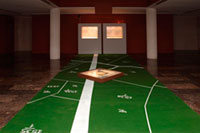early Croatian and mediaeval graveyard of the village of Žestinj with the church of St. George
Author of the exhibition: Tonči Burić, museum consultant
The exhibition was realized by the financial support of the Ministry of Culture of the Republic of Croatia and the town of Kaštela
 At the beginning of summer 2007, some graves were accidentally discovered in Svećurje in Kaštel Novi in the course of building works. Their closer exploration confirmed that they belong to the early Croatian era, i.e. the Early Middle Ages (9th-11th century). During July and August of the same year, with the full-hearted support of the town of Kaštela and the Kaštela Town Museum, a team from the Museum of Croatian Archaeological Monuments conducted protective excavations in the endangered part of the site. In this campaign, 48 graves were discovered and investigated, which comprise only part of a larger early Croatian graveyard.
At the beginning of summer 2007, some graves were accidentally discovered in Svećurje in Kaštel Novi in the course of building works. Their closer exploration confirmed that they belong to the early Croatian era, i.e. the Early Middle Ages (9th-11th century). During July and August of the same year, with the full-hearted support of the town of Kaštela and the Kaštela Town Museum, a team from the Museum of Croatian Archaeological Monuments conducted protective excavations in the endangered part of the site. In this campaign, 48 graves were discovered and investigated, which comprise only part of a larger early Croatian graveyard.
The graveyard on Svećurje in Kaštel Novi must be dated to the late decades of the 9th century (mid second half of the century), i.e. to the time of already intense Christianization. What somewhat separates this graveyard in relationship to other contemporary graveyards in early mediaeval Croatia is the richer typological diversity of the finds, among which completely new shapes were found. A novelty in the overall typological scale of early Croatian jewellery is presented by finds of two necklaces, which were found together with other types of jewellery (rings, earrings). One is particularly interesting. It is made of grains of glass plaste threaded as a necklace in 10 rows across the chest, separated in the middle by a small fragment of the pierced bottom of a late Antiquity glass vessel. Earrings, which can be divided into three major groups, are dominant among the finds. The groups are as follows: single-bead earrings, cluster earrings and ordinary hoops. Particular pleasant finds were those of cluster earrings. Two pairs of the so-called Putalj-type were found, which can be separated as a special regional variety. The finds of single-bead earrings are the most numerous, being the characteristic type of early Croatian jewellery of the Christianized horizon (9th-11th century).
Less than 100 metres north of it, the mediaeval church of St. George of Žestinj (or Mirana) still stands today, around which extends a large mediaeval graveyard. The church and graveyard (both unexplored) belong to the High Middle Ages (approximately from the 12th to the 16th century) and are an integral part of the mediaeval village and parish Žestinj. The massive grave slabs scattered on the assumed area of the graveyard point to the period of the Late Middle Ages and the beginning of the early modern era (14th to 16th century). An older layer of graves also probably exists there, which dates to the High Middle Ages (12th to 13th century).
The church in its present shape was built in rustic Gothic style with a rectangular apse. Only the facade has been renewed several times and has elements of later styles. Above the door is a preserved transom with vegetative decoration in early Romanesque style, which- apart from written documents from the 12th and 13th century- points to the probability of the existence of a Romanesque sacral building underneath today’s church. In front of the church are still visible signs of older walls, which indicate to the possibility of the existence of ancient buildings from the Roman era that belong to a villae rusticae.